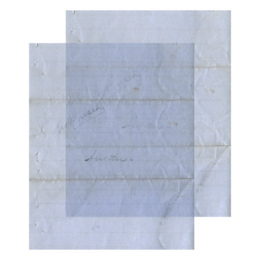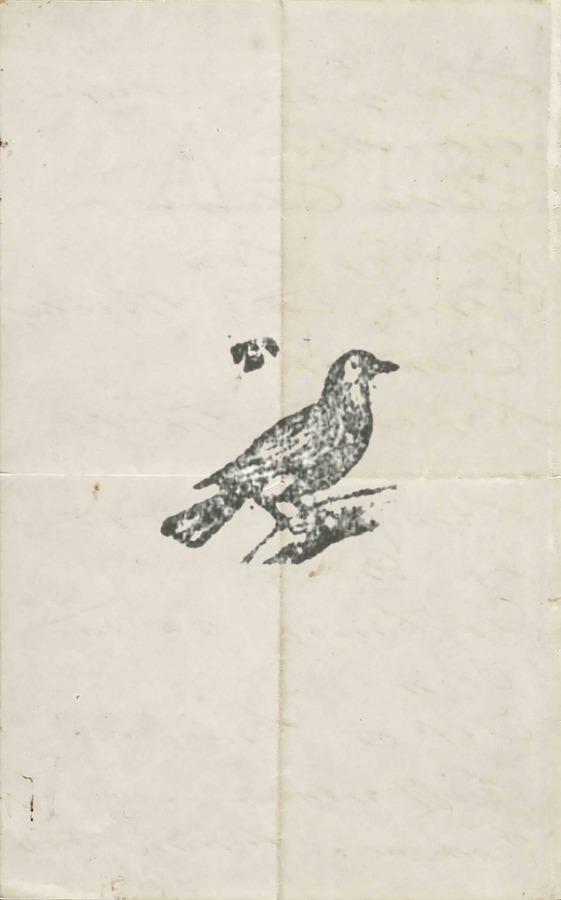 = Original manuscript lost or destroyed
= Original manuscript lost or destroyed
 = Manuscript facsimile coming soon
= Manuscript facsimile coming soon
Scope
The Poem Archive arises out of a capacious database holding 351 manuscript facsimiles representing 237 poems composed by Dickinson and marked by the presence of birds.
Searching the Poem Archive
The search bar allows for keyword searches of the transcriptions of Dickinson's poems; the search menu enables more targeted searches of the archive.
Manuscript Sources
The
Emily Dickinson Archive, an open-access site containing digital surrogates of many of the manuscripts of Dickinson’s poems and letters is the primary source for the manuscript images reproduced here. This project also includes Dickinson manuscripts from the following Libraries:
American Antiquarian Society
Amherst College Archives & Special Collections
Beinecke Library, Yale University
Boston Public Library
Dumbarton Oaks, Harvard University
Forbes Library
Houghton Library, Harvard University
Jones Library
Library of Congress
Middlebury College Library
The Morgan Library & Museum
New York Public Library
Princeton University Library
The Robert P. Esty Library
The Rosenbach Library
Scripps College Library
Smith College Libraries
State Historical Society of Iowa
Vassar Special Collections
Grateful acknowledgment is extended to these libraries and institutions for their contributions. [1]
Transcriptions
- Transcriptions
Transcriptions of Dickinson’s poems are from her manuscripts whenever possible. To ensure the searchability of her texts, we offer limited diplomatic transcriptions rather than typographic facsimiles.
The following fonts distinguish among 3 MS types or registers of preparation and between authorial and non-authorial copies:
- Draft, working copy (initial or subsequent): Antic
- Fair copy (record): Cormorant
- Fair copy (presentation): Cormorant Upright
- Non-authorial transcript: Courier New
Writing in ink appears in a black; writing in pencil appears in gray.
Writing on the MSS in hands other than Dickinson’s is not reproduced but reported in the Notes.
In cases where a poem alluding to a bird or birds is embedded in a letter or letter-draft, the leaves carrying the poem only have been included here; the writing surrounding the poem on those excerpted leaves has not been transcribed but is indicated as follows: [ᔓᔓᔓᔓᔓᔓᔓᔓ].
In cases where a poem alluding to a bird or birds is inscribed on a leaf carrying unrelated poems sans birds, the bird-poem only has been transcribed; the presence of other writings on the same leaves are indicated with [ᔓᔓᔓᔓᔓᔓᔓᔓ].
Transcriptions report the following features of the text:
- Underlining is indicated graphically.
- Canceled text is indicated graphically.
- Additions and Variants:
a. Interlineations (additions, variants) made above or below a line of text are indicated with up and down arrows: ↑ ↓
b. Additions and variants made inline with the text are indicated with right and left arrows: → ←
c. Additions and /or variants made along the right, left, top, or bottom edges of a leaf appear at the end of the text on a given page (or, if the poem has clear divisions, at the end of a division) and are indicated with the following symbols: ↪ (addition/variant inscribed along the right edge), ↩ (addition/variant inscribed along the left edge), ⤴ (addition/variant inscribed along the top edge) , ⤵ (addition/variant inscribed along the bottom edge). The orientation of the writing in relation to the larger text, if different, is noted in the following manner: e.g., ↪: sideways/perpendicular}; ↩sideways/perpendicular}; ⤵: upside-down}; ⤴: upside-down}
d. Additions and/or variants made perpendicularly through the middle of the text appear at the end of the transcription and are indicated with the following symbols, depending on the direction of in which the writing is read: ⇣ (bottom to top), ⇡ (top to bottom)
Note: The symbols above are used to indicate the physical location of writing only, not (primarily) to associate all possible variant readings in a manuscript, where such readings may also appear materially far apart. Readers are encouraged to engage with the ‘unruliness’ of the manuscripts and the ambiguities inherent, especially, to drafts.
- In cases of authorial overwriting, the material altered by overwriting is canceled, immediately followed by the overwritten material surrounded as follows: ⠿overwriting ⠿
- The “x” or “﹢” marks Dickinson often employs to indicate variant readings are represented graphically. ✕ +
- Dickinson’s dashes, though various in form, are represented by n-dashes (–) or, if especially long, by m-dashes (—).
- Dickinson’s “flying” quotation marks are represented by the following special character: “”.
- Authorial Boundary Lines:
a. The authorial association of texts via bracketing is indicated with the following special characters: ⟮ ⟯
b. Authorially-drawn lines indicating the end of a section of a poem are represented graphically, when possible
c. Authorially-drawn lines indicating the end of a poem are represented with the following asset:

- In cases where Dickinson’s writing crosses a material boundary (e.g., a fold, the parts of an envelope, etc.) to continue in another quadrant of the manuscript or where Dickinson chooses a quadrant of the manuscript to use as a revision site for further trials or variants, the relationship of the writing to the quadrant is indicated with the following symbols: ◱ (lower left quadrant); ◲ (lower right quadrant); ◰ (upper left quadrant); ◳ (upper right quadrant); ⬒ (upper quadrant); ⬓ (lower quadrant); ◧ (left quadrant); ◨ (right quadrant).
- In cases where the disposition of the writing on a leaf or sheet appears in a new or different direction following Dickinson’s rotation of the paper, the following symbols mark the nature of the turn: ⍄ (leaf or sheet rotated 90 degrees right); ⍃ (leaf or sheet rotated 90 degrees left); ⍍ (leaf or sheet rotated 180 degrees).
- Page breaks are indicated with
- The authorial use of pins or other fasteners not including fascicle threads is indicated with the symbol ✣ , followed by a note on the fastener type: ✣: strait pin.
- Illegible text in a manuscript is placed in brackets and marked by asterisks, e.g., [****].
- Page (leaf) breaks are indicated with the following symbol: ¦
- Cancelations/mutilations made by an agent other than Dickinson are reported in the notes.
- Editorial notes included in the transcription are in blue.
- The presence of enclosures is indicated with a 🔎 followed by a description of the item, e.g. 🔎: cricket remains.
- Notes: In cases when these forms of representation cannot adequately convey a textual situation, an editorial note describes the crux.
Poem-manuscript dates
Poem dates generally follow those in R. W. Franklin’s The Poems of Emily Dickinson, 3 vols. (Cambridge: The Belknap Press of Harvard University Press, 1998). Dates refer to Manuscript Witnesses rather than Works, and mark the composition, copying, or circulation date of the particular manuscript.
Poem-manuscript paper data
In addition to an examination of the manuscripts themselves (ongoing), data on Dickinson’s paper types is drawn from two scholarly sources: R. W. Franklin’s The Manuscript Books of Emily Dickinson, 2 vols. (Cambridge: The Belknap Press of Harvard University Press, 1986) and Jay Leyda’s cataloging notes at Amherst College, Archives & Special Collections.
Endnotes
[1] The following eleven poems, identified by Jefferey Simons as connected with Dickinson’s lyric ornithology, are not included in dickisnonsbirds: Fr. 1 (juvenilia; outside the temporal boundaries of the archive); Fr 90 (the reference is to a domestic bird: Chanticleer, not a wild bird); Fr 198 (the reference is to a nest only); Fr 1019 (only an implied or ancillary reference to bird); Fr 1182 (only an implied or ancillary reference to bird); Fr 1352 (only an implied or ancillary reference to bird); Fr 1368 (only an implied or ancillary reference to bird); Fr 1408 (only an implied or ancillary reference to bird); Fr 1470 (only an implied or ancillary reference to bird); Fr 1577 (only an implied or ancillary reference to bird); Fr 1603 (only an implied or ancillary reference to bird). See Jefferey Simons, “Dickinson’s Lyric Ornithology,” Emily Dickinson Journal 28.1 (2019): 1-22.